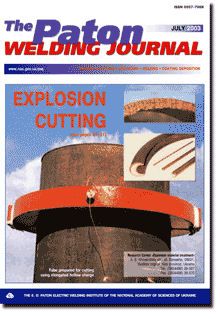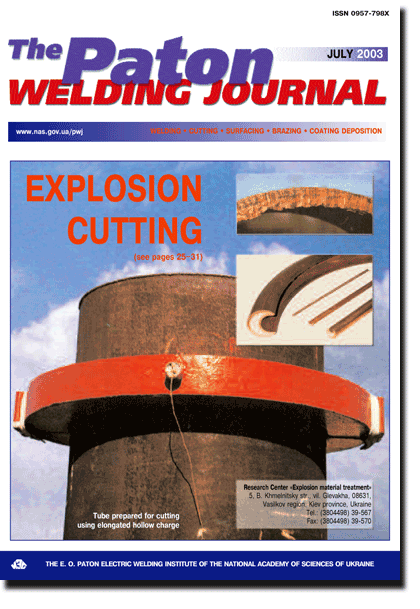Access for download PDF files for subscribers and for reviewers of scientometric bases.
Organization: Elsevier for content access(PDF files of journals released before 2024 are available for download from the website's archives))
Organization: Elsevier for content access(PDF files of journals released before 2024 are available for download from the website's archives))


| SCIENTIFIC AND TECHNICAL | |||||||||||||||||||||||||||||||||||||||||||||||||
| Paton B.E., Lobanov L.M., Tsybulkin G.A.,Makhnenko O.V. and Pereverzev Yu.N. Automated thermal straightening of welded thin-sheet structures. | 2 | ||||||||||||||||||||||||||||||||||||||||||||||||
Automated thermal straightening of welded thin-sheet structures with buckling deformations has been developed. An automated system has been designed for thermal straightening of welded sheet structures, based on application of mathematical simulation, manipulation robot, deformation measurement system and microplasma heat source. Automated thermal straightening allows elimination of skilled manual labour, provides a high quality of the surface of a welded structure sheet, improves process efficiency and ecological characteristics.
| Shonin V.A., Mashin V.S., Vojtenko O.V. andNovozhilov V.V. | Improvement of fatigue resistance of tee welded joints in sheet aluminium alloy AMg6. 7
| It is shown that smoothing of the metal surface on the boundaries of sheet tee joints of aluminium and elimination of angular deformation by high-frequency peening provide a lowering of the values of stress concentration factor 1.6 times. Joint peening increases the ultimate fatigue strength by 40 % at zero-to-compression and by 10 % at repeated stress cycles.
| Dmitrik V.V. and Pashchenko A.N. | Decrease in structural heterogeneity of incomplete refining region of the HAZ of welded joints in pearlitic steels. 11
| Intensity of initiation and development of damage at creep of welded joints in heat-resistant steels is shown to depend upon the kind of initial metal structure in incomplete refining region. Control of temperature conditions of the latter can provide improvement of operational reliability of welded joints.
| Khorunov V.F., Maksimova S.V. and Zvolinsky I.V. | Structure of brazed joints in high nickel alloys produced by using arc heating. 16
| Structure, chemical heterogeneity and microhardness of structural components of brazed joints made by using arc heating and adhesion-active brazing filler alloys of the NiДCrДZr system were studied. The use of brazing filler alloys of optimal composition and appropriate techniques was found to provide deposited metal of low hardness and avoidance of cracking of the brazed weld and the HAZ. Application of composite brazing filler alloys was proved to be most promising for repair of blades of unweldable superalloys with a high (over 60 %) content of the g-phase.
| Pentegov I.V. and Petrienko O.I. | Calculation of temperature distribution along the electrode extension, taking into account the heat contributed by the drop. 19
| A mathematical model has been developed of temperature distribution along the length of electrode extension in consumable electrode CO2 arc welding, allowing for non-linearity of thermophysical coefficients and impact of heat contributed by the drop, which permits calculation of the temperature gradient and temperature in any point on electrode extension (from the nozzle to the drop). Recommendations are given on selection of electrode extension size.
| INDUSTRIAL | Petushkov V.G., Volgin L.A. and Dobrushin L.D. | Explosion cutting and its application. 25
| Principles of the technology for explosion cutting of metal structures using elongated cumulative explosive charges (ECEC) developed by the E.O. Paton Electric Welding Institute are considered. Relationships describing the efficiency of ECEC within the framework of the hydrodynamic theory are presented. Examples of successful application of the explosion cutting technology in some industries are given, including under critical conditions where special measures have to be taken to provide protection from the side effects of explosion.
| Nazarchuk A.T. | Optimizing of condition parameters of narrow-gap arc welding of quenching steels without preheating. 32
| Engineering calculation of optimum rate of cooling metal being welded (to provide the technological strength) depending on welding process parameters and section of weld layers, and also with allowance for CCT diagram of overcooled austenite decay is suggested.
| Basov G.G., Tkachenko A.N. and Efimova N.P. | Experience in manufacture of air tanksof locomotives at HC "Luganskteplovoz". 36
| Designs of a specialized welding equipment are presented and technology of manufacture of air tanks of locomotives is given.
| Pritula S.I., Lebedev V.A. and Tkachenko V.A. | Modular design of the control system for mechanized and automated arc welding. 39
| New types of control systems for welding and surfacing equipment are proposed, which are based on the modular design principle. These developments incorporate engineering solutions on adjustable reversible electric drives, using mechanotronic principles of design, and a programmable controller as the higher hierarchic link.
| BRIEF INFORMATION | Murashov A.P., Astakhov E.A., Demianov I.A. andKapula A.D. | Wear resistance of thermal coatings produced from composite powders "FerroalloyДB4C, SiC". 43
| Wear resistance of coatings under gas-abrasive wear conditions was found to depend on the type of hardening phases synthesized during spraying, as well as on the porosity (cohesion strength) of the coating.
| Lebedev V.A. | Circuit for powering control systems of semi-automatic machines from the welding current source voltage. 45
| The paper describes the possibility of construction of systems of control and regulation, powered by the welding current source voltage. A simple and effective technical solution is proposed, which allows solving both the problem of protection from high-voltage surges during the welding process, and powering the semi-automatic machine systems during short-circuiting of the arc gap. The above technical solution was implemented in a range of semi-automatic machines of modular design of PSh 107V type and is now used in industry, being independent on welding current source applied in the arc welding process.
| Asynchronous welding generator.
| 47
| Advertising.
| 48
| | |||||||||||||
(You are viewing the simplified file contents)
The cost of subscription/purchase order journals or individual articles
| Journal/Currency | Annual Set | 1 issue printed |
1 issue |
one article |
| TPWJ/USD | 384 $ | 32 $ | 26 $ | 13 $ |
| TPWJ/EUR | 348 € | 29 € | 24 € | 12 € |
| TPWJ/UAH | 7200 UAH | 600 UAH | 600 UAH | 280 UAH |
| AS/UAH | 1800 UAH | 300 UAH | 300 UAH | 150 UAH |
| AS/USD | 192 $ | 32 $ | 26 $ | 13 $ |
| AS/EUR | 180 € | 30 € | 25 € | 12 € |
| SEM/UAH | 1200 UAH | 300 UAH | 300 UAH | 150 UAH |
| SEM/USD | 128 $ | 32 $ | 26 $ | 13 $ |
| SEM/EUR | 120 € | 30 € | 25 € | 12 € |
| TDNK/UAH | 1200 UAH | 300 UAH | 300 UAH | 150 UAH |
| TDNK/USD | 128 $ | 32 $ | 26 $ | 13 $ |
| TDNK/EUR | 120 € | 30 € | 25 € | 15 € |
AS = «Automatic Welding» - 6 issues per year;
TPWJ = «PATON WELDING JOURNAL» - 12 issues per year;
SEM = «Electrometallurgy Today» - 4 issues per year;
TDNK = «Technical Diagnostics and Non-Destructive Testing» - 4 issues per year.


